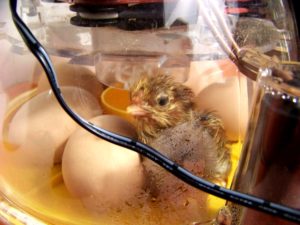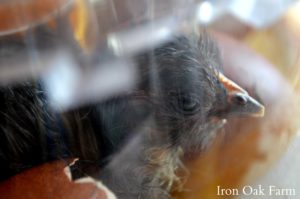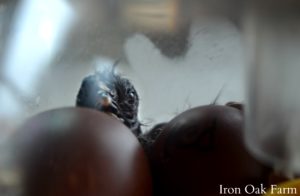How Do You Know if a Baby Chick Is Drying Up in the End
 I simply came in from our coops with a basket of eggs. These eggs will not be eaten. Instead, they will exist going into my incubator. I mark the breed and the date with a pencil and prepare them in a labeled egg carton until I have enough to fill the incubator.
I simply came in from our coops with a basket of eggs. These eggs will not be eaten. Instead, they will exist going into my incubator. I mark the breed and the date with a pencil and prepare them in a labeled egg carton until I have enough to fill the incubator.
This is 1 of my favorite times of the year. I never abound bored with the phenomenon that is witnessed every fourth dimension a chick breaks through the shell and comes into the globe.
Pre-hatch
It takes approximately 21 days for a chick embryo to achieve hatching age. By this fourth dimension, the chick has completely filled the egg and has nowhere left to become but out.
On days nineteen and 20 you may see the eggs wiggling a chip, and you may hear faint peeping through the shell.
The Pip
 The start stage of hatching starts with the pip. The pip is the initial fissure of the eggshell that the chick makes with its egg tooth, a tiny hard nubbin on the end of its neb. This temporary appendage is designed specifically for hatching. The egg tooth will autumn off within the first week every bit the chick grows.
The start stage of hatching starts with the pip. The pip is the initial fissure of the eggshell that the chick makes with its egg tooth, a tiny hard nubbin on the end of its neb. This temporary appendage is designed specifically for hatching. The egg tooth will autumn off within the first week every bit the chick grows.
The pip is commonly a small triangular crack in the eggshell. The chick will work this area until it breaks open a small hole. You will meet the chick working at this small space. You may go glimpses of the neb as it nibbles and wiggles at the small pigsty and will hear it peeping anxiously.
In a typical/normal hatch the chick may stay similar this for quite a while an 60 minutes or two is not uncommon.
The Hinge Hatch
 Equally hatching progresses, the chick will printing against the insides of the eggshell from height to bottom. The chick is coiled inside the small space and it volition put pressure on the shell every bit information technology tries to straighten its trunk out. Information technology volition alternately help the progression by working at the center of the egg and dissecting it in two in a sort of hatch-line-equator.
Equally hatching progresses, the chick will printing against the insides of the eggshell from height to bottom. The chick is coiled inside the small space and it volition put pressure on the shell every bit information technology tries to straighten its trunk out. Information technology volition alternately help the progression by working at the center of the egg and dissecting it in two in a sort of hatch-line-equator.
Eventually, the egg will be connected by a pocket-sized swivel of rubbery membrane. Yous will be able to run across the chick's trunk at this point between pushes. Commonly, in one neat movement, it will eventually break this last bit of membrane and come crashing out exhausted, moisture and floppy.
Hatching is supposed to be a slow process. It tin can take several hours from the first pip to complete hatch. It's not like in cartoons where you lot see the chick burst through the eggshell all in ane boom.
The chick is withal continued to the egg. It takes time for these membranes to dry and disconnect from the shell wall. The chick is also working on building force.
In a normal hatch, the chick will take a few seconds to work at hatching. It may button with swell force, then take a long intermission to recoup its strength.
Hatching Problems
 ix times out of ten, a difficult hatch is due to humidity problems. Usually, the humidity isn't loftier enough, and the chick gets shrink-wrapped inside the shell.
ix times out of ten, a difficult hatch is due to humidity problems. Usually, the humidity isn't loftier enough, and the chick gets shrink-wrapped inside the shell.
Shrinkwrap is where the inner membrane of the egg, the rubbery layer beneath the shell, starts to dry out out. As it does, the membrane becomes tough and inflexible.
Often times the chick isn't stiff enough to breakthrough.
When to Help
 Assisting in a hatch is more oftentimes than not a fruitless endeavor. Information technology must be a last resort type of activeness. Oft when a chick has been assisted in a hatch it will die a few hours to a few days afterward.
Assisting in a hatch is more oftentimes than not a fruitless endeavor. Information technology must be a last resort type of activeness. Oft when a chick has been assisted in a hatch it will die a few hours to a few days afterward.
I sometimes wonder if at that place is something more incorrect when a chick is unable to break through on its own. Sort of nature's cruel test of endurance.
So if in that location is nothing else to be done and the chick volition die anyway, and then you have nothing to lose simply endeavour to help.
Often, if you have a problem egg/chick. The other chicks will have already pipped and hatched while the trouble egg is notwithstanding in the pip stages.
Signs that you may demand to step in:
- If the egg isn't progressing and information technology's been several hours
- If the membrane around the egg seems to be getting tough and shrinking, adding more humidity might help, but unremarkably, at this point it's also late.
To Assist
 Piece of work very slowly, again the chick is still attached to the eggshell and then any sudden movements can crusade the chick to bleed to decease.
Piece of work very slowly, again the chick is still attached to the eggshell and then any sudden movements can crusade the chick to bleed to decease.
Only remove a small bit at a time and see if the chick can progress on its ain. Often you lot may see the membrane is sort of shredded in strips that the chick tin't pause. Try gently tearing these strips and see if the chick can take it from there.
Give the chick some time between assisting. Ever remember to move slowly and only remove parts of the shell that are absolutely necessary.
If you're planning on hatching out chicks this spring, research how the humidity in your specific incubator is regulated. Information technology's a very important factor that tin can make or interruption a successful hatch.
Source: https://www.communitychickens.com/hatching-day-will-happen-help-chick/
Post a Comment for "How Do You Know if a Baby Chick Is Drying Up in the End"